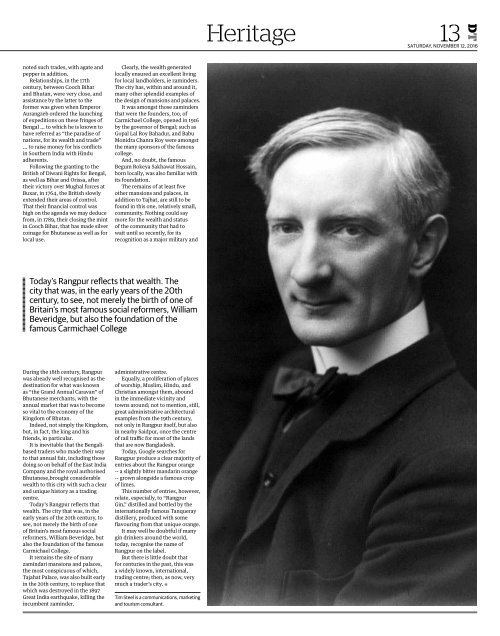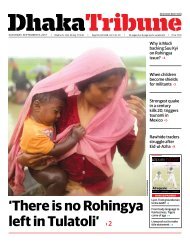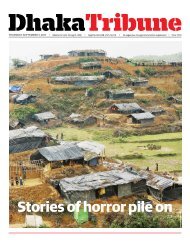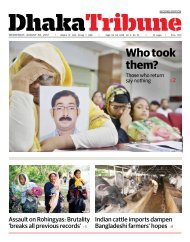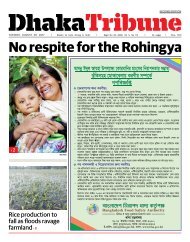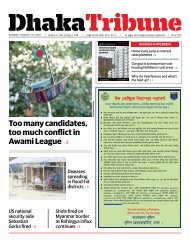DT e-Paper, Saturday, 12 November, 2016
You also want an ePaper? Increase the reach of your titles
YUMPU automatically turns print PDFs into web optimized ePapers that Google loves.
Heritage<br />
13<br />
SATURDAY, NOVEMBER <strong>12</strong>, <strong>2016</strong><br />
<strong>DT</strong><br />
noted such trades, with agate and<br />
pepper in addition.<br />
Relationships, in the 17th<br />
century, between Cooch Bihar<br />
and Bhutan, were very close, and<br />
assistance by the latter to the<br />
former was given when Emperor<br />
Aurangzeb ordered the launching<br />
of expeditions on these fringes of<br />
Bengal … to which he is known to<br />
have referred as “the paradise of<br />
nations, for its wealth and trade”<br />
... to raise money for his conflicts<br />
in Southern India with Hindu<br />
adherents.<br />
Following the granting to the<br />
British of Diwani Rights for Bengal,<br />
as well as Bihar and Orissa, after<br />
their victory over Mughal forces at<br />
Buxar, in 1764, the British slowly<br />
extended their areas of control.<br />
That their financial control was<br />
high on the agenda we may deduce<br />
from, in 1789, their closing the mint<br />
in Cooch Bihar, that has made silver<br />
coinage for Bhutanese as well as for<br />
local use.<br />
Clearly, the wealth generated<br />
locally ensured an excellent living<br />
for local landholders, ie zaminders.<br />
The city has, within and around it,<br />
many other splendid examples of<br />
the design of mansions and palaces.<br />
It was amongst those zaminders<br />
that were the founders, too, of<br />
Carmichael College, opened in 1916<br />
by the governor of Bengal; such as<br />
Gopal Lal Roy Bahadur, and Babu<br />
Monidra Chanra Roy were amongst<br />
the many sponsors of the famous<br />
college.<br />
And, no doubt, the famous<br />
Begum Rokeya Sakhawat Hossain,<br />
born locally, was also familiar with<br />
its foundation.<br />
The remains of at least five<br />
other mansions and palaces, in<br />
addition to Tajhat, are still to be<br />
found in this one, relatively small,<br />
community. Nothing could say<br />
more for the wealth and status<br />
of the community that had to<br />
wait until so recently, for its<br />
recognition as a major military and<br />
Today’s Rangpur reflects that wealth. The<br />
city that was, in the early years of the 20th<br />
century, to see, not merely the birth of one of<br />
Britain’s most famous social reformers, William<br />
Beveridge, but also the foundation of the<br />
famous Carmichael College<br />
During the 18th century, Rangpur<br />
was already well recognised as the<br />
destination for what was known<br />
as “the Grand Annual Caravan” of<br />
Bhutanese merchants, with the<br />
annual market that was to become<br />
so vital to the economy of the<br />
Kingdom of Bhutan.<br />
Indeed, not simply the Kingdom,<br />
but, in fact, the king and his<br />
friends, in particular.<br />
It is inevitable that the Bengalibased<br />
traders who made their way<br />
to that annual fair, including those<br />
doing so on behalf of the East India<br />
Company and the royal authorised<br />
Bhutanese,brought considerable<br />
wealth to this city with such a clear<br />
and unique history as a trading<br />
centre.<br />
Today’s Rangpur reflects that<br />
wealth. The city that was, in the<br />
early years of the 20th century, to<br />
see, not merely the birth of one<br />
of Britain’s most famous social<br />
reformers, William Beveridge, but<br />
also the foundation of the famous<br />
Carmichael College.<br />
It remains the site of many<br />
zamindari mansions and palaces,<br />
the most conspicuous of which,<br />
Tajahat Palace, was also built early<br />
in the 20th century, to replace that<br />
which was destroyed in the 1897<br />
Great India earthquake, killing the<br />
incumbent zaminder.<br />
administrative centre.<br />
Equally, a proliferation of places<br />
of worship, Muslim, Hindu, and<br />
Christian amongst them, abound<br />
in the immediate vicinity and<br />
towns around; not to mention, still,<br />
great administrative architectural<br />
examples from the 19th century,<br />
not only in Rangpur itself, but also<br />
in nearby Saidpur, once the centre<br />
of rail traffic for most of the lands<br />
that are now Bangladesh.<br />
Today, Google searches for<br />
Rangpur produce a clear majority of<br />
entries about the Rangpur orange<br />
-- a slightly bitter mandarin orange<br />
-- grown alongside a famous crop<br />
of limes.<br />
This number of entries, however,<br />
relate, especially, to “Rangpur<br />
Gin,” distilled and bottled by the<br />
internationally famous Tanqueray<br />
distillery, produced with some<br />
flavouring from that unique orange.<br />
It may well be doubtful if many<br />
gin drinkers around the world,<br />
today, recognise the name of<br />
Rangpur on the label.<br />
But there is little doubt that<br />
for centuries in the past, this was<br />
a widely known, international,<br />
trading centre; then, as now, very<br />
much a trader’s city. •<br />
Tim Steel is a communications, marketing<br />
and tourism consultant.


